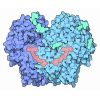+ Open data
Open data
- Basic information
Basic information
| Entry | Database: PDB / ID: 7om4 | ||||||
|---|---|---|---|---|---|---|---|
| Title | Nanobody EgB4 bound to the full extracellular EGFR-EGF complex | ||||||
 Components Components |
| ||||||
 Keywords Keywords | IMMUNE SYSTEM / EGFR / nanobody / cancer / signaling | ||||||
| Function / homology |  Function and homology information Function and homology informationpositive regulation of hyaluronan biosynthetic process / negative regulation of secretion / negative regulation of cholesterol efflux / positive regulation of epithelial tube formation / positive regulation of cerebellar granule cell precursor proliferation / regulation of protein localization to cell surface / positive regulation of protein localization to early endosome / cerebellar granule cell precursor proliferation / regulation of calcium ion import / transmembrane receptor protein tyrosine kinase activator activity ...positive regulation of hyaluronan biosynthetic process / negative regulation of secretion / negative regulation of cholesterol efflux / positive regulation of epithelial tube formation / positive regulation of cerebellar granule cell precursor proliferation / regulation of protein localization to cell surface / positive regulation of protein localization to early endosome / cerebellar granule cell precursor proliferation / regulation of calcium ion import / transmembrane receptor protein tyrosine kinase activator activity / Developmental Lineage of Pancreatic Acinar Cells / positive regulation of ubiquitin-dependent protein catabolic process / Differentiation of Keratinocytes in Interfollicular Epidermis in Mammalian Skin / multivesicular body, internal vesicle lumen / negative regulation of cardiocyte differentiation / positive regulation of peptidyl-threonine phosphorylation / epidermal growth factor receptor binding / Shc-EGFR complex / positive regulation of protein kinase C signaling / Inhibition of Signaling by Overexpressed EGFR / epidermal growth factor receptor activity / EGFR interacts with phospholipase C-gamma / regulation of receptor signaling pathway via JAK-STAT / regulation of peptidyl-tyrosine phosphorylation / positive regulation of DNA binding / epidermal growth factor binding / NFE2L2 regulating tumorigenic genes / response to UV-A / PLCG1 events in ERBB2 signaling / ERBB2-EGFR signaling pathway / morphogenesis of an epithelial fold / PTK6 promotes HIF1A stabilization / ERBB2 Activates PTK6 Signaling / branching morphogenesis of an epithelial tube / digestive tract morphogenesis / Signaling by EGFR / intracellular vesicle / negative regulation of epidermal growth factor receptor signaling pathway / eyelid development in camera-type eye / cerebral cortex cell migration / protein insertion into membrane / ERBB2 Regulates Cell Motility / protein tyrosine kinase activator activity / Respiratory syncytial virus (RSV) attachment and entry / Signaling by ERBB4 / positive regulation of receptor internalization / PI3K events in ERBB2 signaling / positive regulation of phosphorylation / mammary gland alveolus development / positive regulation of peptidyl-serine phosphorylation / Estrogen-dependent nuclear events downstream of ESR-membrane signaling / hair follicle development / MAP kinase kinase kinase activity / GAB1 signalosome / positive regulation of G1/S transition of mitotic cell cycle / embryonic placenta development / salivary gland morphogenesis / ERK1 and ERK2 cascade / positive regulation of endothelial cell proliferation / Signaling by ERBB2 / TFAP2 (AP-2) family regulates transcription of growth factors and their receptors / GRB2 events in EGFR signaling / SHC1 events in EGFR signaling / transmembrane receptor protein tyrosine kinase activity / EGFR Transactivation by Gastrin / positive regulation of endothelial cell migration / positive regulation of mitotic nuclear division / GRB2 events in ERBB2 signaling / ossification / SHC1 events in ERBB2 signaling / basal plasma membrane / positive regulation of DNA repair / platelet alpha granule lumen / cellular response to epidermal growth factor stimulus / guanyl-nucleotide exchange factor activity / positive regulation of DNA replication / epithelial cell proliferation / positive regulation of epithelial cell proliferation / Signal transduction by L1 / positive regulation of protein localization to plasma membrane / NOTCH3 Activation and Transmission of Signal to the Nucleus / cellular response to amino acid stimulus / growth factor activity / phosphatidylinositol 3-kinase/protein kinase B signal transduction / cellular response to estradiol stimulus / EGFR downregulation / clathrin-coated endocytic vesicle membrane / Signaling by ERBB2 TMD/JMD mutants / Constitutive Signaling by EGFRvIII / cell-cell adhesion / receptor protein-tyrosine kinase / Signaling by ERBB2 ECD mutants / negative regulation of protein catabolic process / Signaling by ERBB2 KD Mutants / positive regulation of miRNA transcription / kinase binding / ruffle membrane / Downregulation of ERBB2 signaling / epidermal growth factor receptor signaling pathway / positive regulation of protein phosphorylation Similarity search - Function | ||||||
| Biological species |  Homo sapiens (human) Homo sapiens (human) | ||||||
| Method |  X-RAY DIFFRACTION / X-RAY DIFFRACTION /  SYNCHROTRON / SYNCHROTRON /  MOLECULAR REPLACEMENT / Resolution: 6.05 Å MOLECULAR REPLACEMENT / Resolution: 6.05 Å | ||||||
 Authors Authors | Zeronian, M.R. / Janssen, B.J.C. | ||||||
 Citation Citation |  Journal: Bmc Mol Cell Biol / Year: 2022 Journal: Bmc Mol Cell Biol / Year: 2022Title: Structural insights into the non-inhibitory mechanism of the anti-EGFR EgB4 nanobody. Authors: Zeronian, M.R. / Doulkeridou, S. / van Bergen En Henegouwen, P.M.P. / Janssen, B.J.C. | ||||||
| History |
|
- Structure visualization
Structure visualization
| Structure viewer | Molecule:  Molmil Molmil Jmol/JSmol Jmol/JSmol |
|---|
- Downloads & links
Downloads & links
- Download
Download
| PDBx/mmCIF format |  7om4.cif.gz 7om4.cif.gz | 345.2 KB | Display |  PDBx/mmCIF format PDBx/mmCIF format |
|---|---|---|---|---|
| PDB format |  pdb7om4.ent.gz pdb7om4.ent.gz | 284.7 KB | Display |  PDB format PDB format |
| PDBx/mmJSON format |  7om4.json.gz 7om4.json.gz | Tree view |  PDBx/mmJSON format PDBx/mmJSON format | |
| Others |  Other downloads Other downloads |
-Validation report
| Summary document |  7om4_validation.pdf.gz 7om4_validation.pdf.gz | 471.9 KB | Display |  wwPDB validaton report wwPDB validaton report |
|---|---|---|---|---|
| Full document |  7om4_full_validation.pdf.gz 7om4_full_validation.pdf.gz | 479 KB | Display | |
| Data in XML |  7om4_validation.xml.gz 7om4_validation.xml.gz | 29.1 KB | Display | |
| Data in CIF |  7om4_validation.cif.gz 7om4_validation.cif.gz | 38.4 KB | Display | |
| Arichive directory |  https://data.pdbj.org/pub/pdb/validation_reports/om/7om4 https://data.pdbj.org/pub/pdb/validation_reports/om/7om4 ftp://data.pdbj.org/pub/pdb/validation_reports/om/7om4 ftp://data.pdbj.org/pub/pdb/validation_reports/om/7om4 | HTTPS FTP |
-Related structure data
| Related structure data | 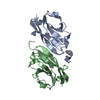 7om5C 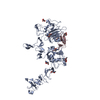 3njpS S: Starting model for refinement C: citing same article ( |
|---|---|
| Similar structure data |
- Links
Links
- Assembly
Assembly
| Deposited unit | 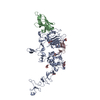
| ||||||||
|---|---|---|---|---|---|---|---|---|---|
| 1 | 
| ||||||||
| Unit cell |
|
- Components
Components
| #1: Protein | Mass: 69709.297 Da / Num. of mol.: 1 Source method: isolated from a genetically manipulated source Source: (gene. exp.)  Homo sapiens (human) / Gene: EGFR, ERBB, ERBB1, HER1 / Production host: Homo sapiens (human) / Gene: EGFR, ERBB, ERBB1, HER1 / Production host:  Homo sapiens (human) Homo sapiens (human)References: UniProt: P00533, receptor protein-tyrosine kinase | ||||
|---|---|---|---|---|---|
| #2: Protein | Mass: 6229.027 Da / Num. of mol.: 1 Source method: isolated from a genetically manipulated source Source: (gene. exp.)  Homo sapiens (human) / Gene: EGF / Production host: Homo sapiens (human) / Gene: EGF / Production host:  | ||||
| #3: Antibody | Mass: 14195.455 Da / Num. of mol.: 1 Source method: isolated from a genetically manipulated source Source: (gene. exp.)   | ||||
| #4: Sugar | ChemComp-NAG / Has ligand of interest | N | Has protein modification | Y | |
-Experimental details
-Experiment
| Experiment | Method:  X-RAY DIFFRACTION / Number of used crystals: 1 X-RAY DIFFRACTION / Number of used crystals: 1 |
|---|
- Sample preparation
Sample preparation
| Crystal | Density Matthews: 10.27 Å3/Da / Density % sol: 88.03 % |
|---|---|
| Crystal grow | Temperature: 293 K / Method: vapor diffusion, sitting drop Details: 0.1 M LiSO4, 0.1 M glycine pH 10.5, 1.1 M sodium dihydrogen phosphate and 0.72 M dipotassium hydrogen phosphate |
-Data collection
| Diffraction | Mean temperature: 100 K / Serial crystal experiment: N |
|---|---|
| Diffraction source | Source:  SYNCHROTRON / Site: SYNCHROTRON / Site:  Diamond Diamond  / Beamline: I24 / Wavelength: 0.9686 Å / Beamline: I24 / Wavelength: 0.9686 Å |
| Detector | Type: DECTRIS PILATUS3 6M / Detector: PIXEL / Date: Jan 31, 2019 |
| Radiation | Protocol: SINGLE WAVELENGTH / Monochromatic (M) / Laue (L): M / Scattering type: x-ray |
| Radiation wavelength | Wavelength: 0.9686 Å / Relative weight: 1 |
| Reflection | Resolution: 6.05→153.81 Å / Num. obs: 6321 / % possible obs: 91.8 % / Redundancy: 9.6 % / CC1/2: 0.996 / Rmerge(I) obs: 0.187 / Rpim(I) all: 0.065 / Rrim(I) all: 0.199 / Net I/σ(I): 7.8 |
| Reflection shell | Resolution: 6.05→7.15 Å / Rmerge(I) obs: 1.995 / Mean I/σ(I) obs: 1.6 / Num. unique obs: 632 / CC1/2: 0.548 / Rpim(I) all: 0.642 / Rrim(I) all: 2.099 |
- Processing
Processing
| Software |
| |||||||||||||||||||||||||||||||||||||||||||||||||||||||||||||||||||||||||||||||||||||||||||||||||||||||||||||||||||||||||||||||||||||||||||||||||||||||||||||||||||||||||||||||
|---|---|---|---|---|---|---|---|---|---|---|---|---|---|---|---|---|---|---|---|---|---|---|---|---|---|---|---|---|---|---|---|---|---|---|---|---|---|---|---|---|---|---|---|---|---|---|---|---|---|---|---|---|---|---|---|---|---|---|---|---|---|---|---|---|---|---|---|---|---|---|---|---|---|---|---|---|---|---|---|---|---|---|---|---|---|---|---|---|---|---|---|---|---|---|---|---|---|---|---|---|---|---|---|---|---|---|---|---|---|---|---|---|---|---|---|---|---|---|---|---|---|---|---|---|---|---|---|---|---|---|---|---|---|---|---|---|---|---|---|---|---|---|---|---|---|---|---|---|---|---|---|---|---|---|---|---|---|---|---|---|---|---|---|---|---|---|---|---|---|---|---|---|---|---|---|---|
| Refinement | Method to determine structure:  MOLECULAR REPLACEMENT MOLECULAR REPLACEMENTStarting model: 3NJP Resolution: 6.05→153.81 Å / SU ML: 0.97 / Cross valid method: THROUGHOUT / σ(F): 1.34 / Phase error: 37.58 / Stereochemistry target values: ML
| |||||||||||||||||||||||||||||||||||||||||||||||||||||||||||||||||||||||||||||||||||||||||||||||||||||||||||||||||||||||||||||||||||||||||||||||||||||||||||||||||||||||||||||||
| Solvent computation | Shrinkage radii: 0.9 Å / VDW probe radii: 1.11 Å / Solvent model: FLAT BULK SOLVENT MODEL | |||||||||||||||||||||||||||||||||||||||||||||||||||||||||||||||||||||||||||||||||||||||||||||||||||||||||||||||||||||||||||||||||||||||||||||||||||||||||||||||||||||||||||||||
| Displacement parameters | Biso max: 853.59 Å2 / Biso mean: 534.9126 Å2 / Biso min: 329.55 Å2 | |||||||||||||||||||||||||||||||||||||||||||||||||||||||||||||||||||||||||||||||||||||||||||||||||||||||||||||||||||||||||||||||||||||||||||||||||||||||||||||||||||||||||||||||
| Refinement step | Cycle: final / Resolution: 6.05→153.81 Å
| |||||||||||||||||||||||||||||||||||||||||||||||||||||||||||||||||||||||||||||||||||||||||||||||||||||||||||||||||||||||||||||||||||||||||||||||||||||||||||||||||||||||||||||||
| LS refinement shell | Refine-ID: X-RAY DIFFRACTION / Rfactor Rfree error: 0 / Total num. of bins used: 2
| |||||||||||||||||||||||||||||||||||||||||||||||||||||||||||||||||||||||||||||||||||||||||||||||||||||||||||||||||||||||||||||||||||||||||||||||||||||||||||||||||||||||||||||||
| Refinement TLS params. | Method: refined / Refine-ID: X-RAY DIFFRACTION
| |||||||||||||||||||||||||||||||||||||||||||||||||||||||||||||||||||||||||||||||||||||||||||||||||||||||||||||||||||||||||||||||||||||||||||||||||||||||||||||||||||||||||||||||
| Refinement TLS group |
|
 Movie
Movie Controller
Controller




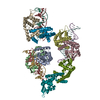

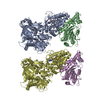

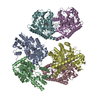
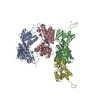

 PDBj
PDBj


















